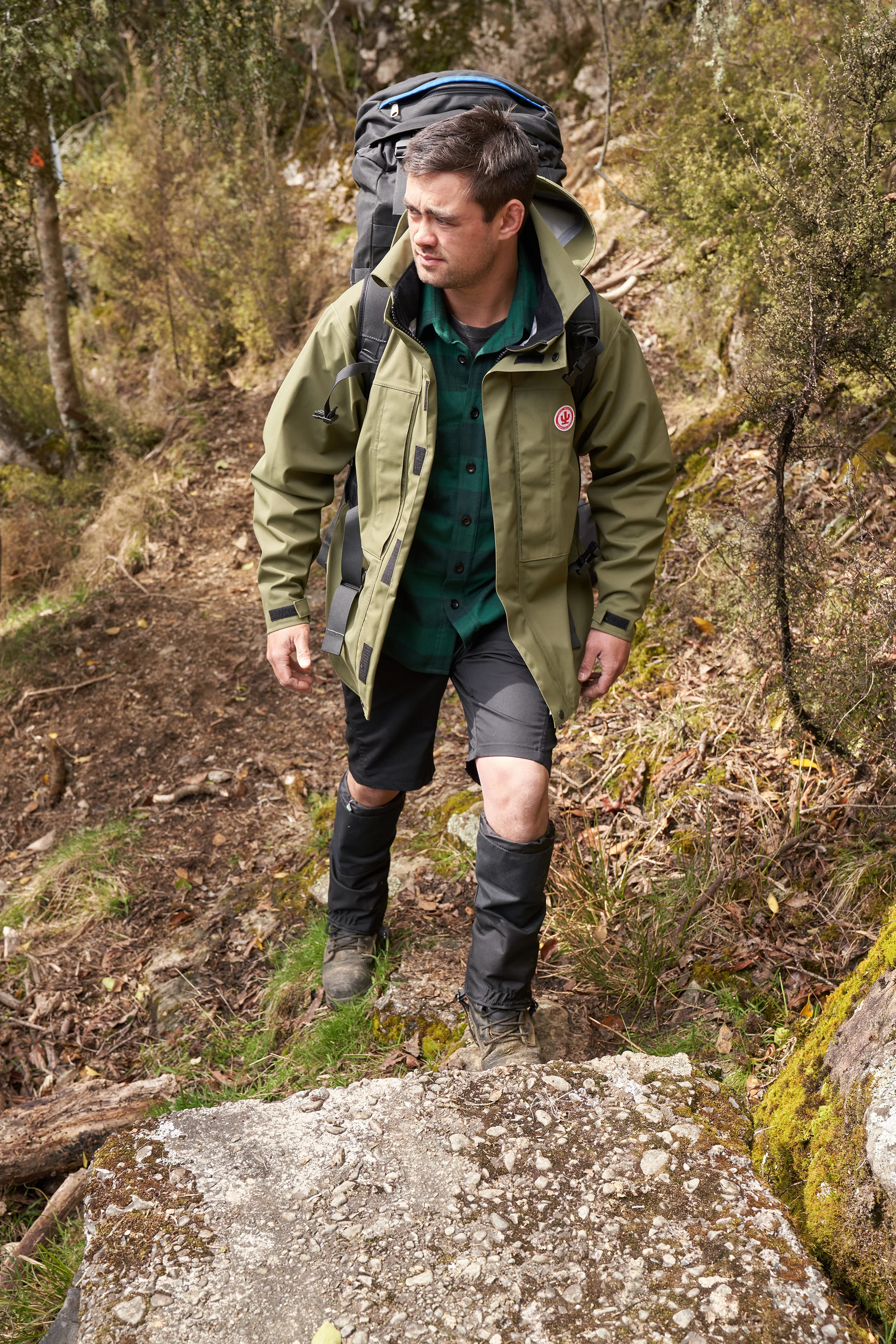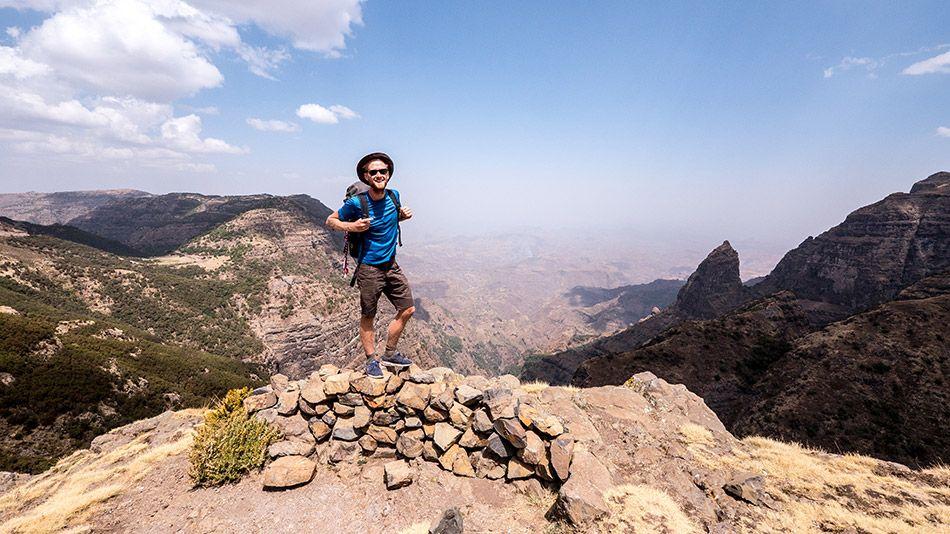Mat is the perfect Cactus ambassador. He has an amazing job, travelling the globe, filming wildlife for numerous impressive documentaries including for the BBC. He also doesn't hold back when he has time off for some personal adventuring. Here's something he wrote about his year living and filming in Africa.
Since purchasing my first pair of Cactus Supertrousers before a shoot for BBC’s ‘Spy in the Wild’ in New Caledonia, I have been interested to see how ‘tough’ this piece of clothing really is. After spending 20 days, every day, in the trousers on that shoot, I was convinced they were made of a mythical material similar to what may be seen in the Lord of the Rings... I continued to use and abuse them in many different locations until I was offered the chance to work on a Natural History Documentary in Tanzania, Africa.
Before the trip to Africa, my understanding of the place was that the entire continent was either bone dry or in constant thunderstruck jungle - it proved to be more of a mix (although the locals are becoming more and more confused as to what season is what now)... Armed with a Miklat Pack, Cactus Merino Tee and the Supertrousers mentioned before, I was thrown into an environment that initially felt very flat and foreign. As my knowledge grew, it felt like the land began to reveal itself and the flat, featureless Savanna was being etched into my memory - trees would become catching features, certain terminate mounds would be referenced in my diary as where we filmed certain animals. My attention to detail adapted itself, and what initially appeared to be ‘nothing’ evolved into a very feature-full landscape.
To spend a year in Tanzania was a truly unbelievable experience. It was a rollercoaster year for the planet - with Brexit, Trump and the ever-increasing horror stories of what the planet is revealing to us about our expanding/‘progressing’ activity. Despite all this, being out here, such political and social influences really don’t change anything (immediately anyway) - if you can eliminate contact with the outside world and just react according to the local environment, life seems much slower and ‘real’. The psychological influence such lengthy exposure has allowed me to once again be reminded what is truly important in life - witnessing the life of key characters (animals) we filmed day after day revealed to me what the essence of life is for almost every other species we share this planet with - it seems we have deviated from this natural pathway, neglecting some of the most important characteristics of what makes us human. After 10 trips to the country, seven books of notes taken, I have come away much more aware of the natural world and these ecosystems that are so different than the Avian wonderland I came from...
To witness constantly an ecosystem that seems complete was absolutely incredible. The most obvious example is the aftermath of a hunt. When witnessing a lion hunting it instantly attracts many nosy neighbours. Vultures from the sky begin circling and settling in nearby trees, hyena begin popping their heads out of holes and bushes, jackal bravely begin trotting about on the outskirts of the kill site. When the lion’s belly looks as though they have swallowed a barrel, the others sequentially move in… Hyenas rush to the site (always keeping an eye on the activity of the lions) they begin a frenzied feast (the laughing and howling is something that you cannot help but laugh at). Vultures and hyena seem to have an alliance that sees them (mostly) feed side by side, later the hyena move on and the jackal move in (they often get chased and chase the vultures). Eventually, the vultures are the last ones left and will stay about for a number of days (depending on the size of the kill). Finally, when the food is digested, the dung beetles go to town (there are other contributors but these mentioned are the obvious - consistent ones). The sequence of visitors to an event like this is such a brilliant example of how key components of the ecosystem are imperative to the function of the ecosystem. Other than witnessing it underwater in New Zealand, I haven’t been able to see a real example of ecosystem processes in such an obvious way. This really got me thinking about what back home we have lost and what would have given a comparable spectacle. I feel that the legacy of what I was able to see and film will forever be an example of what the natural world should be like (although this is a pocket of what there once was here - it still can be a great reference to future conservation goals).
The one animal out here that had the biggest influence on me (literally physically) was the tsetse fly (like a sandfly, but instead of a microneedle, a horse tranquilliser needle). The situation of needing to have the most precise focus filming while this (f***ing) fly drilled its way into your spine was something that Cactus canvas really saved the day with. It appeared that although my top half was open to attack, my legs were shielded with a tsetse proof fabric. I soon found that the heat of the dry season made the Supertrousers incredibly hot to wear, fortunately, the Supershorts proved to be a welcome exchange.
The longevity of the clothing I wore certainly surprised me. Having spent my entire life in the outdoors (mainly in New Zealand) I have worn out a good amount of gear.
In 2012 I began Conservation work in Fiordland. For this, we were provided with a Cactus Deepwinter Pack. Despite being constantly filled with eggs and meat (which in the summer would sometimes turn into a concoction of meaty egg juice), thrown from helicopters, dragged over rocks and through thick bush, the packs were unbelievably hardy (they could be filled with water at the end of a trip and still seemed waterproof!), it was fantastic to find a company that was prioritising quality and hardiness, especially for the way we Kiwis like to travel in the outdoors. My loyalty for New Zealand Made outdoor equipment was strengthened not only because of the quality and fact that real ‘people’ could be consulted but because the ethics from production to sales were completely in line with what I want to see more of in society.
For my time in Tanzania, Rwanda, Ethiopia (Africa) I had the following Cactus clothing:
- Miklat pack (accompanied every field excursion).
- Slim Supertrousers (ultimate tsetse fly shield - featured in the 'Making of Spy in the Wild').
- Men's Merino Tee (blue - tsetse flies favourite colour - yet only discovered this after arriving).
- Lightweight Supershorts (worn for 45 days consecutively - 16 hours a day).
- Men's Merino Daily Fix Long Sleeve (worn every morning).
- Windhoody (worn every morning).
- Gold Digger Hat (washed once when covered in hyena slobber - worn every day = 3920 hours)
- Pod wallet (very useful - stored memory cards and pain killers)
- BBB - Big Burly Bag (handles 32kg no problem - I had a UK canvas bag of a similar size that has accumulated numerous holes - the Cactus BBB is hole-free!)
To check out what else Mat gets up to take a look at his Instagram here. It's truly amazeballs!


